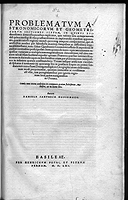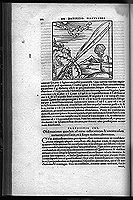 Fig. 51
Fig. 51  Fig. 52
Fig. 52
All the many varieties of sights and levels only had a practical purpose if the gunner knew the relation between elevation and range for the guns under his command. From Tartaglia's first publication on artillery onwards, such tables of 'randons' were promised and printed. Yet the precise nature of the shot's trajectory remained a thorny issue for mathematicians from the 16th to the 18th centuries, and beyond. Tartaglia had adapted the terms of academic natural philosophy to offer his 'new science' of artillery and Galileo announced the parabolic nature of the projectile's motion in his own 'new science' of falling bodies. Attempts to incorporate the problematic effects of air resistance led to increasingly sophisticated mathematical treatments in the later 17th and 18th centuries, but these rapidly outstripped the reach of ordinary gunners.
Accounts of ballistics based on Tartaglia remained standard in gunnery manuals long after alternative notions were available. However his views were not uniformly adopted by early practitioners. Some authors, such as father and son Leonard and Thomas Digges (catalogue no. 45), explicitly rejected Tartaglia's ideas. Other authors, such as Daniel Santbech, seem not to have been aware of his writings.
Santbech's discussion shows how quickly artillery became a subject of learned discourse as well as practical art, since his account appears in a more general mathematical text encompassing astronomy, sundials, surveying, and levelling for water courses. He sets out to investigate gunnery theoretically on the firm foundations of geometry, quoting Euclid and Ptolemy in the Greek, while using the geometrical quadrant discussed elsewhere in his text as the necessary instrumental accompaniment.
At first glance his illustrations of straight-lined trajectories with abruptly acute angles appear absurd. However, they are depicted for calculating convenience rather than graphic realism. Santbech acknowledged that a cannon ball would not fly in a straight line and then suddenly fall directly to the ground. He substituted a straight line for the actual path of the shot so that he could create a right-angled triangle from which ranges were computed with the help of a table of sines.